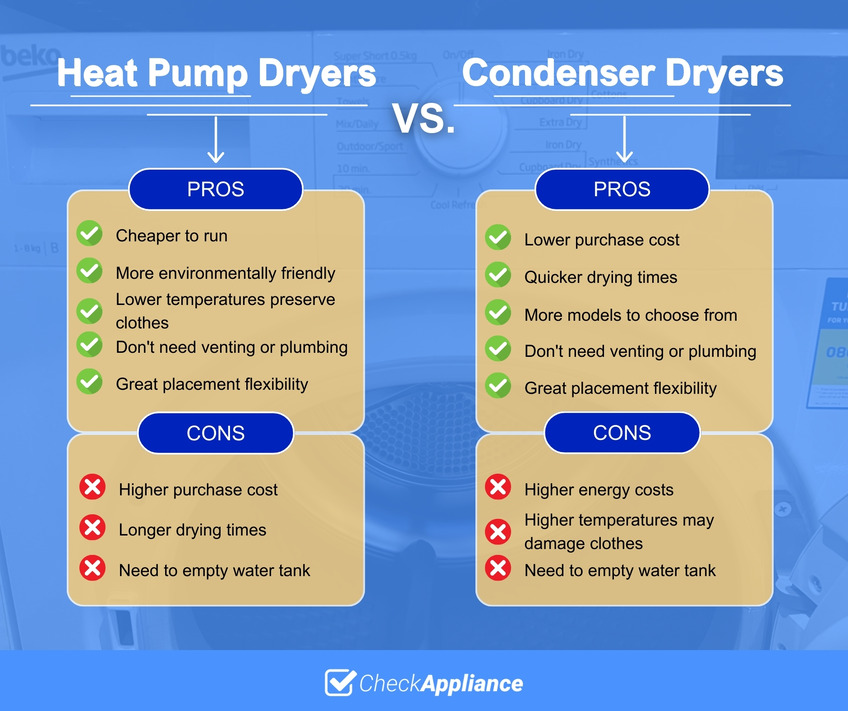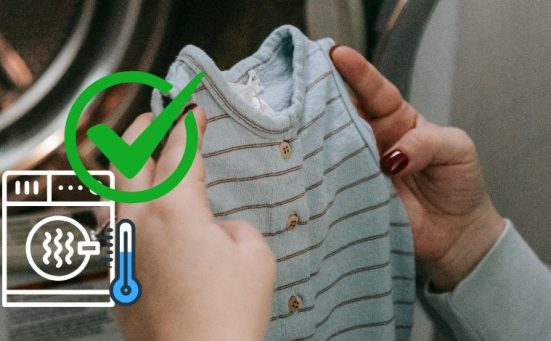
Does A Heat Pump Tumble Dryer Need A Vent?
If you’re looking to replace your existing tumble dryer with a newer model you’ve probably noticed heat pump dryers. One of the first questions we often get asked about heat pump tumble dryers is do they need a vent?
The short answer is no, heat pump tumble dryers don’t need a vent. But there’s way more to heat pump dryers than that, keep reading for the full story.
What Is A Heat Pump Tumble Dryer?
The original tumble dryers were all vented which means they relied on a vent to remove hot air from the appliance. These vented dryers worked well enough but they were inefficient, wasted energy and cost more to run.
Condenser Dryers
Then came condenser dryers which eliminated the need for the vent by condensing the hot moist air and converting it to water which was contained in an on-board reservoir.
Condenser dryers work well and allow you the flexibility to place them anywhere (within reason) without the need to vent hot air to the outside of your home. The main problem with condenser dryers is how much energy they consume.
Because they heat the air that passes through the laundry to temperatures in excess of 70 degrees C, they consume more energy compared to heat pump dryers.
Heat Pump Dryers
Heat pump dryers employ the condenser system to store water in an on-board water reservoir but they reuse the warm air that’s left behind after the water is extracted. As this air is still warm it takes less energy to heat it back up again.
Added to which, heat pump dryers don’t heat the air any higher than around 50 degrees C which means they use less energy anyway.
The water collected in the on-board water tank will need to be emptied fairly regularly or on some models you can install a drainage hose which runs directly into the house drainage system. This eliminates the need to empty the water reservoir.
You’ll need to consult the specifications of the model you choose if you prefer to have a self draining system. Because this option is not available on all models.
How Does A Heat Pump Dryer Work?
Heat pump dryers work by passing warm air through the drum which absorbs moisture from your laundry. The warm air then passes through a condenser which separates the water from the air.
The water is collected in an on-board reservoir or water tank while the now dry air is recycled back into the drum after being reheated to the required temperature.
As this air is already fairly warm, it doesn’t take much energy to get it back up to the required temperature (which is 20 to 25 degrees C cooler than the air required in condenser dryers).
Do Heat Pump Dryers Need A Vent?
As the hot moist air is passed through a condenser and the dry air recycled back through the drum over and over, there is no need for a vent. This means that heat pump dryers can be placed almost anywhere in your home.
They don’t need to be placed near an outside wall or window because there is no vent hose to consider. This means there’s no need for holes in the wall, open windows on cold days or remembering to clean the vent and the vent hose.
Plus all of the water collected in the condenser is stored in a water tank inside the dryer so there’s no need for any plumbing either.
What Are The Differences Between Heat Pump Dryers & Condenser Dryers?

Neither condenser dryers or heat pump dryers need, or have a vent and they both condense the hot moist air and turn it into water which is stored on-board in a water tank or reservoir. The difference is in what happens to the air that’s left after the water has been extracted.
On condenser dryers that air is released into the room which means the dryer needs to constantly replace air into the dryer and then heat it up to the required temperature (70 to 75 C) which uses more energy.
Heat pump dryers on the other hand, recycle that warm air and pump it back into the drum to dry the laundry. As this air is already hotter than room temperature, it uses less energy to achieve the required drying temperature which is only around 50 C.
The lower required drying temperature and the reusing of already warm air, both contribute to the lower running costs of heat pump dryers.
However, heat pump dryers cost more to buy than condenser dryers but as they have significantly lower running costs it doesn’t take long to save on the extra purchase costs.
The lower required drying temperature which is significantly lower on heat pump dryers might save on energy bills but there is a down side. Which is they take considerably longer to get the laundry dry.
However this also means that your clothes are less likely to get damaged or shrink and will therefore last longer.

What Are The Benefits Of Heat Pump Tumble Dryers
We’ve pretty much covered all of the benefits of heat pump dryers but let’s go over them once more.
- Heat pump dryers are cheaper to run
Due to their advanced technology, heat pump dryers reuse warm air and run at lower temperatures than condenser dryers. This means an estimated saving of around £50 per year! - They’re environmentally friendly
Using less energy means heat pump dryers are more environmentally friendly. Heat pump dryers can use around 50% less energy compared to vented or condenser dryers. - They help preserve your clothes
As they operate at lower temperatures, heat pump dryers are gentler on the fabrics of your laundry. Plus, as they use moisture sensors to detect the exact point when your laundry is dry, there is less chance of your clothes overheating. - They can be placed anywhere (within reason)
As heat pump dryers don’t need to be plumbed in or have a vent hose to allow hot, moist air to leave your home, they can be installed pretty much anywhere.
What Are The Disadvantages Of Heat Pump Tumble Dryers?
It’s not all good news however, let’s take a quick look at the disadvantages now which include;
- Higher purchase price
The average cost of a heat pump dryer is around £200 more than the other types of dryers. However, as more manufacturers introduce newer heat pump models, the price is slowly lowering. - Take significantly longer to dry clothes
Because heat pump dryers typically use lower drying temperatures of around 50 C (compared to around 70 to 75 C on condenser dryers), they do take significantly longer to dry your laundry. - Require some maintenance
You will need to regularly empty the water tank and you will also need to clean the condenser box and the area below the condenser box as well.
Do I Need A Heat Pump Tumble Dryer?
Whether you need a heat pump dryer or not is really a question only you can answer. If you care about the environment, want to save money on energy bills, are fed up with having to clean the vent and vent hose and would like the freedom to install a dryer anywhere you like. Then you probably do need a heat pump dryer.
SEE ALSO: Heat Pump Vs Condenser Tumble Dryer (what’s the difference & which to choose)
Frequently Asked Questions
As they require no plumbing and don’t need venting, heat pump tumble dryers can be put almost anywhere (within reason).
The types of tumble dryers that don’t need venting are condenser dryers and heat pump dryers. Both of these rely on a condenser to extract the water from the hot air which is collected in an on-board water tank. This eliminates the need for a vent to allow the wet air to leave the appliance and your home.
As heat pump tumble dryers collect water in an on-board water tank and reuse the warm air from the dryer over and over, they can be put in a cupboard. As long as the cupboard has some ventilation to allow air to be taken into the appliance.
Heat pump tumble dryers require no vent as all of the moisture is extracted by a condenser. However, like all electrical appliances, heat pump dryers do require some air flow to prevent the appliance from overheating.
Also, follow us on Pinterest ...



